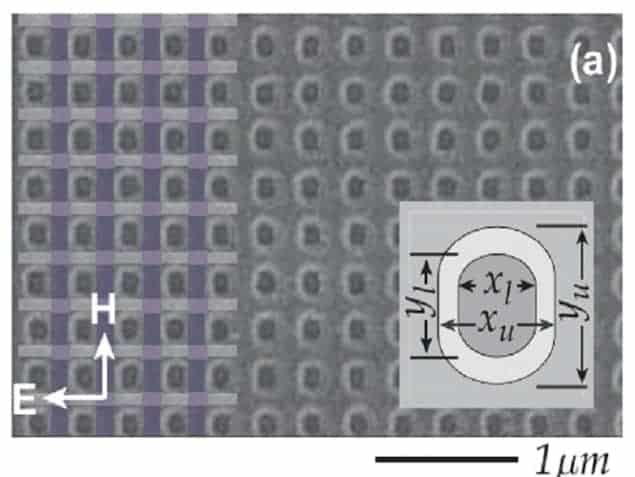Researchers in the US have created a metamaterial that has a negative magnetic permeability and negative electric permittivity for infrared light with a wavelength of 813 nm. This is claimed to be the shortest wavelength yet for such a metamaterial and lies just outside of the visible spectrum at 380-780 nm. The previous record had been about 1500 nm, and the result is an important step towards the creation of double-negative negative-index metamaterials (DN-NIMs) that operate in the visible range.

Naturally occurring materials have a positive index of refraction, whereas a negative-index metamaterial (NIM) has a structure that is engineered artificially to have a negative index of refraction. NIMs have a number of desirable properties that do not exist in normal materials including the ability to focus light to a point smaller than its wavelength in a so-called “superlens”, which could allow optical microscopes to view much smaller objects than possible today.
A negative index of refraction can occur when only the permittivity of the material is negative and the permeability, although positive, is different from that in free space. However, the effect is much more pronounced (and more technologically useful) in DN-NIMs, in which both permittivity and permeability are negative.
While NIM metamaterials have been developed with negative permittivities for visible light, negative permeability is much more difficult to achieve because the magnetic interaction between light and a metamaterial is more than 100 times weaker than the electrical interaction.
Speaking at the recent March Meeting of the American Physical Society in Denver, Vladimir Shalaev of Purdue University, Indiana, unveiled a new DN-NIM that is tantalizingly close to the visible range. The metamaterial is a thin sheet comprising two layers of silver separated by alumina. The structure is perforated with a regular array of rectangular-shaped holes to create a “fishnet” pattern. The holes are about 120 nm across and are separated by about 300 nm. The magnetic permeability of the material was found to be negative for light with wavelengths between about 799 and 818 nm, while the permittivity is negative from about 700 to beyond 900 nm.
Shalaev told Physics Web that the fishnet structure could be adapted to create a DN-NIM for visible light – something that he and his colleagues are working on right now. However, he cautioned that fishnet NIMs display negative permeability over a relatively narrow band of wavelengths and therefore it is unlikely that a single structure could be used to create a DN-NIM that works throughout the visible spectrum. Also, some of the light passing through fishnet NIMs is absorbed, which means that it could not be used as a superlens. However, he believes that such metamaterials could be used to achieve sub-wavelength imaging using other schemes including a “hyperlens”, which aims to covert near-field evanescent waves into waves that can be focussed to create a far-field image.



